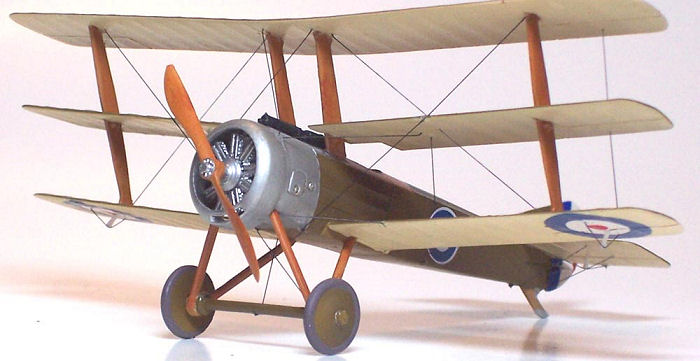
| KIT: | Revell 1/72 Sopwith Triplane |
| KIT #: | H-44 |
| PRICE: | $Long out of Production |
| DECALS: | Three options |
| REVIEWER: | Kyle Bodily |
| NOTES: |

| HISTORY |
The Sopwith Triplane or as it was
known to its pilots “Tripehound” was developed from the Pup in late 1916. The
purpose of the triplane configuration was to maximize pilot visibility. This
was done by narrowing the wing cord but maintaining wing area by adding a third
wing. This did improve visibility to a point, but what it did do was truly
amazing and unexpected. The folks at
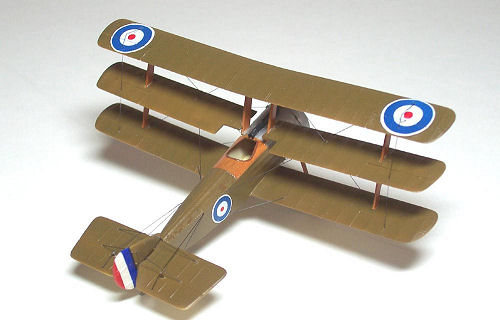 Sopwith inadvertently created a very high
aspect wing. A high aspect wing is characterized by very high lift ratios
coupled with high drag ratios. That is why high aspect wings are not used on
aircraft that need to go fast. We see them today on B-52s, U-2s and gliders.
I.E. lots of lift, not much speed. If you want lift, high aspect will give it
to you. Since speed was not that high at this time what you got was an aircraft
that could climb and turn very well. The end result was an incredibly
maneuverable fighter that in my opinion did more to defeat the Germans in the
air then any other single aircraft type. The German pilots feared the
Tripehound more than any other Allied fighter.
Sopwith inadvertently created a very high
aspect wing. A high aspect wing is characterized by very high lift ratios
coupled with high drag ratios. That is why high aspect wings are not used on
aircraft that need to go fast. We see them today on B-52s, U-2s and gliders.
I.E. lots of lift, not much speed. If you want lift, high aspect will give it
to you. Since speed was not that high at this time what you got was an aircraft
that could climb and turn very well. The end result was an incredibly
maneuverable fighter that in my opinion did more to defeat the Germans in the
air then any other single aircraft type. The German pilots feared the
Tripehound more than any other Allied fighter.
To say its impact was profound would be an understatement. Because of it, the German aircraft manufacturers were told to stop what they were doing and ordered to submit designs for triplane fighters within weeks of the appearance of the Tripehound. The Germans however could not produce an adequate triplane and the much touted Fokker Dr.I was a dismal failure that cost the Germans dearly in time and national fortune. To say nothing of the fact that two of Germany’s greatest aces were killed at the controls of the Dr.I.
The Sopwith Triplane was slightly
slower than the Albatros D.III, however it could easily out climb and out turn
the German aircraft. The only real advantage that the Germans had over the
Tripe was that the German aircraft had twin machine guns while the Tripe had
only one. The German could only safely hit and run the Tripe. If the Germans
got in to a turning battle they needed to, at the very least outnumber the
Tripes. Otherwise the Tripes would quickly turn inside of the Germans. This
would leave the Germans only one option to save their skins and that was to dive
away from the battle. Even the Albatros could out dive the Tripehound. However
you had to make this decision before you ran out of altitude or you could, as
they say “Run out of Airspeed,
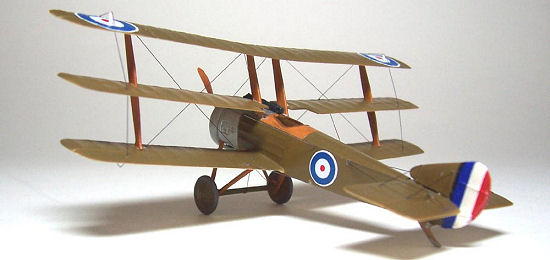 Altitude and Ideas all at the same time”. This
would be a good way to become a statistic.
Altitude and Ideas all at the same time”. This
would be a good way to become a statistic.
The Tripe was flown by some of the best RNAS pilots. The Sopwith Triplane helped to re-establish Allied air superiority in the Flanders sector of the Western Front following Bloody April. Collishaw and Bob Little flew a limited-production series of Triplane with the infamous Black Flight of Naval Squadron No.10. These aircraft were armed with two machine guns. Despite the reduction in performance from the additional weight added by the second gun and ammo this Heavy Tripe was quite liked by the RNAS pilots who flew them and quite feared by the Germans.
The Sopwith Triplane was only in front line service for about a year. All of the RNAS squadrons flew this aircraft and all pilots who flew them seemed to like the Tripehound. You don’t seem to read too many bad things about this aircraft, unlike the Sopwith Camel that replaced it.
| THE KIT |
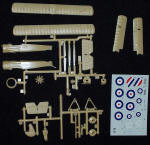 This is a very simple kit. Some
twenty-five beige injection molded parts. You get both the early and late
horizontal stabilizers. There is a little flash but it’s not bad at all. I
like the rib detail, it is quite nicely done for an old kit like this is. The
only drawbacks to this kit are that there is no interior, just a pilot, and the
landing gear is a little chunky.
This is a very simple kit. Some
twenty-five beige injection molded parts. You get both the early and late
horizontal stabilizers. There is a little flash but it’s not bad at all. I
like the rib detail, it is quite nicely done for an old kit like this is. The
only drawbacks to this kit are that there is no interior, just a pilot, and the
landing gear is a little chunky.
The instructions are easy to follow and consist of three steps with painting information where needed. The decals are for three aircraft and look like they will work well. I think that I will build a generic aircraft and I think that these decals will do fine. So there it is.
| CONSTRUCTION |
As I said earlier that this was a simple kit. I built it out of the box and did not add anything that was not in the kit.
I started by painting and gluing the
engine and cockpit. I glued the fuselage halves together and put on the bottom
wings. At this point I drilled all the holes for the rigging and painted. I
w anted a basic Triplane with varnished wood cockpit decking. I like the look of
wood on WWI aircraft and find it fun to do. So I do wood every chance I get.
anted a basic Triplane with varnished wood cockpit decking. I like the look of
wood on WWI aircraft and find it fun to do. So I do wood every chance I get.
After the paint dried I finished assembly and added the decals. All went well but that is to be expected from these old kits. Even though they are old most of these were well engineered and do go together well.
| COLORS & MARKINGS |
Like I said I am building a generic Tripehound. If you are going to paint a basic British airplane of the WWI variety, the under side was usually clear doped linen. The top side was usually PC-10, which could range in color from a brown to green. The engine and cowling were usually unpainted and the struts, propeller and cockpit decking was varnished wood. Like I’ve been saying, an easy uncomplicated build. From start to finish one weekend and an evening to rig. That includes drying time, breaks and a trip to get a BigGulp from 7-11.
| CONCLUSIONS |
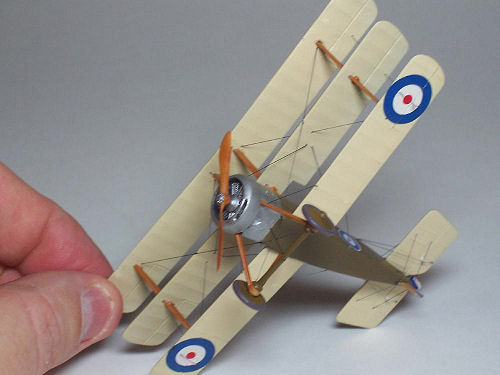 This was an easy kit and I would
recommend it to most modelers. I cut my teeth on kits like this. They are well
engineered and help to train a new generation of modelers. I believe that model
companies would do good to produce kits like this. We can’t all start out on
complicated and expensive kits. Especially if you don’t know if you will even
like the hobby.
This was an easy kit and I would
recommend it to most modelers. I cut my teeth on kits like this. They are well
engineered and help to train a new generation of modelers. I believe that model
companies would do good to produce kits like this. We can’t all start out on
complicated and expensive kits. Especially if you don’t know if you will even
like the hobby.
All in all this is the best/only 1/72 scale kit of this aircraft that I know of. I know of no other company that has plans to produce a Sopwith Triplane. Since this kit is out of production you can only get it from a collector or an online auction. I really wish that Revell would release some of their old World War One kits. Even though they are in some cases eclipsed by newer offerings they are definitely a fun trip down memory lane. I bet somewhere in the dark recesses of your memory, you just may have built this kit. I know that for me, this is probably my fifteenth build of this kit.
February 2006
| REFERENCES |
“Windsock Datafile #22 SOPWITH TRIPLANEI” Albatros Productions LTD
“Fighter Aircraft of the 1914-1918 War” Harleyford Publications limited Letchworth, Herts
“Sopwith Fighters in Action” Squadron/Signal Publications, By Peter Cooksley
If you would like your product reviewed fairly and quickly by a site that has over 300,000 visitors a month, please contact me or see other details in the Note to Contributors.